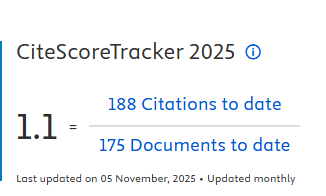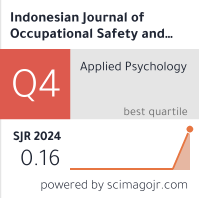Factor Analysis in the Implementation of Early Warning System Documentation in Psychiatric Hospitals
Downloads
Introduction: An early warning system (EWS) is a tool to rapidly identify patient deterioration and prevent adverse events. However, the implementation and documentation have not been carried out optimally. This study aims to analyze factors related to the implementation of EWS documentation in a psychiatric hospital in Malang. Methods: The study was an analytical observational study with a cross-sectional design. The study population was all nurses in the intensive care unit of the hospital, with a total sample of 60 respondents selected using a proportional random sampling technique. Data collection used demographic data questionnaires, workload questionnaires, and observation sheets for the implementation of EWS documentation of patients through the hospital management information system. Analysis of the data used the chi-square test. Results: Implementation of EWS documentation was significantly related to workload and EWS training (p<0.05). Implementation of EWS documentation was not related to age, gender, education level, years of service, employment status, and work shift (p>0.05). Conclusion: Nurses with light workloads and who had attended EWS training created good documentation successfully (100%). Hospitals need to review their management in planning, developing, and fostering nursing resources, especially the provision of continuous training accompanied by equitable EWS monitoring for nurses in psychiatric hospitals.
Ang, R.J. (2019) ‘Use of Content Management Systems to Address Nursing Workflow', International Journal of Nursing Sciences, 6(4), pp. 454–459.
Dewi, B.A.M., Susila, I.M.D.P. and Darmawan, A.A.K.N. (2020) ‘Pengaruh Penggunaan Adult Early Warning Scoring (AEWS) Terhadap Tingkat Mortalitas Di Rsud Bali', Jurnal Kesehatan Saelmakers PERDANA, 3(2), pp. 334–343.
De Groot, K. et al. (2022) ‘Patient Participation in Electronic Nursing Documentation: An Interview Study among Home-Care Patients', Health Expectations, 25(4), pp. 1508–1516.
Hapsari, N.K.A.T. et al. (2021) ‘Efektivitas Pelatihan Tutorial Simulasi Early Warning Score (EWS) COVID-19 Dewasa terhadap Pengetahuan dan Kinerja Tenaga Kesehatan dalam Pendokumentasian di RSUD Sanjiwani, Gianyar, Indonesia', Intisari Sains Medis, 12(3), pp. 710-717.
Hidayat, D.I., Agushybana, F. and Nugraheni, S.A. (2020) ‘Early Warning System pada Perubahan Klinis Pasien terhadap Mutu Pelayanan Rawat Inap', Higeia Journal of Public Health Research and Development, 4(3), pp. 506–519.
Hwang, J.I. and Kim, S.W. (2022) ‘Using an Early Warning Score for Nurse Shift Patient Handover: Before-and-after Study', Asian Nursing Research, 16(1), pp. 18–24.
Khair, M. N., La Ubo, N. and Mustari, N. (2019) ‘Hubungan Lama Menderita Diabetes Mellitus Tipe II dengan Kejadian Komplikasi Polineuropati Diabetik di Wilayah Kerja Puskesmas Antang Perumnas Kecamatan Manggala Kota Makassar', Jurnal Media Keperawatan: Politeknik Kesehatan Makassar, 10(2), pp. 85–91.
Langkjaer, C.S. et al. (2021) ‘Nurses' Experiences and Perceptions of two Early Warning Score systems to Identify Patient Deterioration”A Focus Group Study', Nursing Open, 8(4), pp. 1788–1796.
Larjow, E. and Lingner, T. (2022) ‘Resource use of Geriatric Nurses Due to Documentation Practices: A Cross-Sectional Study of Applied Recording Techniques in Nursing Homes', Nursing Open, 9(2), pp. 1126–1135.
Mayenti, F., Arif, Y. and Priscilla, V. (2020) ‘Analysis of Factors Related to The Documentation of Nursing Care', STRADA Jurnal Ilmiah Kesehatan, 9(2), pp. 503–514.
Megawati, S.W. et al. (2021) ‘Evaluasi Penerapan Early Warning Score di Ruang Rawat Inap Dewasa', Jurnal Keperawatan Muhammadiyah, 6(1), pp. 4–7.
Nantschev, R. and Ammenwerth, E. (2022) ‘Challenges using Electronic Nursing Routine Data for Outcome Analyses: A Mixed Methods Study', International Journal of Nursing Sciences, 9(1), pp. 92–99.
O'Neill, S.M. et al. (2021) ‘Why do Healthcare Professionals Fail to Escalate as per the Early Warning System (EWS) Protocol? A Qualitative Evidence Synthesis of the Barriers and Facilitators of Escalation', BMC Emergency Medicine, 21(1), pp. 1–19.
Potter, P.A. and Perry, A.G. (2015) Buku Ajar Fundamental Keperawatan: Konsep, Proses, Dan Praktik. 4th edn. Jakarta: EGC.
Ratag, A.C. and Kartika, L. (2021) ‘Hubungan Pengetahuan dan Motivasi Perawat terhadap Pelaksanaan Early Warning System (EWS) di Rumah Sakit Swasta di Indonesia Tengah', Jurnal Keperawatan Raflesia, 3(1), pp. 45–54.
Reyaan, H., Marti, E. and Widyastuti, C. S. (2022) ‘"Faktor-Faktor yang Berhubungan Dengan Tingkat Pengetahuan Perawat dan Bidan Tentang Early Warning System (EWS) Di Ruang Rawat Inap Salah Satu Rumah Sakit Swasta Yogyakarta', Jurnal Kesehatan Karya Husada, 10(2), pp. 73–85.
Sujalmo, P. et al. (2022) ‘Original Article Nurses' Perception on The Initial Implementation Of An Early Warning System: A Mixed-Method Study', Jurnal Keperawatan Soedirman, 17(1), pp. 29–35.
Tamaka, R.S., Mulyadi and Malara, R. (2015) ‘Hubungan Beban Kerja Dengan Pendokumentasian Asuhan Keperawatan Di Instalasi Gawat Darurat Medik RSUP. Prof.Dr.R.D Kandou Manado', e-Journal Keperawatan, 3(2), pp. 1–7.
Tobing, K.I.S. (2018) ‘Efektifitas Elektronik Early Warning System dalam Identifikasi Perburukan Neonatus di Unit Perawatan Intensif: Studi Literatur Review', Journal of Borneo Holistic Health, 1(2), pp. 170-179.
Widegdo, H., Marti, E. and Ratnawati, E. (2022) ‘Hubungan Antara Beban Kerja Dengan Kepatuhan Perawat Dalam Pendokumentasian Early Warning System (EWS) Di Ruang Rawat Inap Rumah Sakit Panti Rahayu Gunung Kidul', Jurnal Keperawatan I CARE, 3(2), pp. 158–167.
Wu, Q. et al. (2015) ‘Effect of an Inpatient Nursing Risk Early Warning and Control System in Shanghai: A Retrospective Study of Adverse Events', International Journal of Nursing Sciences, 2(2), pp. 190–194.

This work is licensed under a Creative Commons Attribution-NonCommercial-ShareAlike 4.0 International License.

In order to be accepted and published by The Indonesian Journal of Occupational Safety and Health, Author(s) who submit an article should complete all the review process. The copyright of received articles assigned to the The Indonesian Journal of Occupational Safety and Health and Department of Safety and Health, Universitas Airlangga as publishers of the journal. The intended copyright includes the rights to publish articles in various forms (including reprints).
The Editorial Team of The Indonesian Journal Of Occupational Safety and Health and Department of Safety and Health strive to ensure that no errors occur in the articles that have been published, both data errors and statements in the article.
Users of this website will be licensed to use materials from this website following the Creative Commons Attribution-NonCommercial-ShareAlike 4.0 International License. No fees charged. Please use the materials accordingly.
------------------------------------------------------------------------------------------------------------------------------------------------------------------------------------------
Attribution ” You must give appropriate credit, provide a link to the license, and indicate if changes were made. You may do so in any reasonable manner, but not in any way that suggests the licensor endorses you or your use.
NonCommercial ” You may not use the material for commercial purposes.
ShareAlike ” If you remix, transform, or build upon the material, you must distribute your contributions under the same license as the original.







 How to Submit Articles in OJS
How to Submit Articles in OJS

























